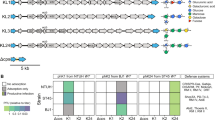Summary
Experiments were carried out to determine the relative effect of homology inside or outside of the capsular genomes of donor and recipient strains of pneumococci on the frequency of transfer of capsular markers. In one series of experiments, 3 recipient strains were transformed to CapIII+ by DNA from 2 donor strains. Recipient strains (III)capIII D6 1, (II)capIII D15 P1 1, and (II)capII-1 1 were each transformed to CapIII+ at different absolute frequencies dependent upon the amount of genetic information that the strain had to acquire. The chromosomal background of the donor strain carrying the CapIII capsular genome had no influence on the results, however, for each strain was transformed at the same frequency by DNA from donor strain (II)CapIII+ or donor strain (III)CapIII+. In a second series of experiments, 2 (I)CapIII-strains, a (II)CapIII-strain and a (III)CapIII-strain were transformed to heterologous type I and binary type I-III with DNA from donor strains (I)CapI+, (II)CapI+, and (III)CapI+. Again, the chromosomal background of the donor strain was unimportant to the results. The origin of the recipient strain, however, markedly influenced the frequency of transformation. (I)CapIII-strains were transformed to CapI+ at about 10 times the frequency and to CapI-III at from 18–6000 times the frequency of the other CapIII-strains. Consideration of the results leads to the conclusion that transformation of CapIII-strains to CapI+ and transformation of CapI-strains to CapIII+ are not reciprocal reactions; CapI-strains lose less information in transformation to CapIII+ than CapIII-strains gain in transformation to CapI+. In (I)CapIII-recipient strains, the residual information from the CapI capsular genome is responsible for the higher frequency of transformation to both CapI+ and to CapI-III. It is suggested that addition of exogenous linear DNA to a recipient chromosome to give rise to binary strains occurs when sequence homology with the recipient is limited to one end of a piece of transforming DNA. Models to explain the results (Figs. 1 through 3) are consistent with the experimental findings and are amenable to further testing.
Similar content being viewed by others
References
Austrian, R., Bernheimer, H. P., Smith, E. E. B., Mills, G. T.: Simultaneous production of two capsular polysaccharides by pneumococcus II. The genetics and biochemical bases of binary capsulation. J. exp. Med. 110, 585–602 (1959).
Berheimer, H. P., Wermundsen, I. E.: Unstable binary capsulated transformants in pneumococcus. J. Bact. 98, 1073–1079 (1969).
Bernheimer, H. P., Wermundsen, I. E., Austrian, R.: Qualitative differences in the behavior of pneumococcal deoxyribonucleic acids transforming to the same capsular type. J. Bact. 93, 320–333 (1967).
Bernheimer, H. P., Wermundsen, I. E., Austria, R.: Mutation in pneumococcus type III affecting multiple cistrons concerned with the synthesis of capsular polysaccharide. J. Bact. 96, 1099–1102 (1968).
Burton, K.: A study of the conditions and mechanisms of the diphenylamine reaction for the colorimetric estimation of deoxyribonucleic acid. Biochem. J. 62, 315–323 (1956).
Curtiss, R. III: Bacterial conjugation. Ann. Rev. Microbiol. 23, 43–68 (1969).
Demerec, M., Adelberg, E. A., Clark, A. J., Hartman, P. E.: A proposal for a uniform nomenclature in bacterial genetics. Genetics 54, 61–76 (1966).
Guy, A. C. E., How, M. J., Stacey, M., Heidelberger, M.: The capsular polysaccharide of type I pneumococcus. I. Purification and chemical modification. J. biol. Chem. 242, 5106–5111 (1967).
Hotchkiss, R. D.: Procedures in nucleic acid research, eds. Cantoni, G. L. and Davies, D. R., New York and London: Harper and Row 1966.
Lacks, S.: Integration efficiency and genetic recombination in pneumococcal transformation. Genetics 53, 207–235 (1966).
Mäkelä, P. H., Stocker, B. A. D.: Genetics of polysaccharide biosynthesis. Ann. Rev. Genet. 3, 291–322 (1969).
Author information
Authors and Affiliations
Additional information
Communicated by W. Maas
Rights and permissions
About this article
Cite this article
Bernheimer, H.P., Wermundsen, I.E. Homology in capsular transformation reactions in Pneumococcus . Molec. gen. Genet. 116, 68–83 (1972). https://doi.org/10.1007/BF00334261
Received:
Issue Date:
DOI: https://doi.org/10.1007/BF00334261




